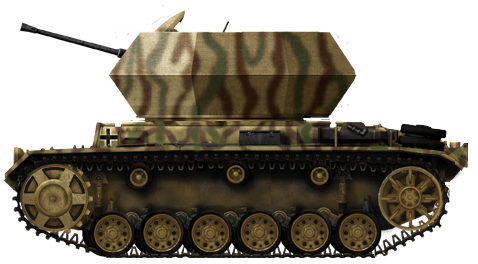3.7cm Flak-43 flakpanzer-III
 Germany: Full name 3.7 cm Flak 43 in Keksdose-Turm auf Panzerkampfwagen III Fahrgestell (1944)- 11-18 built
Germany: Full name 3.7 cm Flak 43 in Keksdose-Turm auf Panzerkampfwagen III Fahrgestell (1944)- 11-18 built
The second Flakpanzer III
Introduction
The development of Flakpanzer (anti-aircraft tanks) in late 1943 as the Luftwaffe definitely lost its mastery of the air on all fronts (North Africa, Italy, W. Europe and the eastern front) and to not waste time in development it was chosen for organic AA defence to convert existing Panzer III or Panzer IV chassis, after the earlier experience with the FlakPanzer-I, in concurrence of the equally light, Panzer 38(t) based Flakpanzer 38(t). One of the early tests were made with a quad 20 mm autocannon mount borrowed from the Kriegsmarine, placed on a Panzer III chassis. This was in complement to the improvized Sd.Kfz.10/4, Sd.Kfz.6/2, Sd.Kfz.7/1 and other half-track based solutions.
The rival project Flakpanzer IV Wirbelwind, quite successful.
While the Panzer IV based Wirbelwind was tested, and then produced, the artillery branch – Inspectorate 4 wanted a similar vehicle for their own assault artillery units, and since it used the StuG III it was decided to adopt the Panzer III chassis for the sake of standardization. By October 1944, a military delegation visited Deutsche-Eisenwerke in Duisburg to review AA turret designs and wanted for the future Flakpanzer III ordered from November 1944, a monthly delivery of four fo every 30 StuG III chassis. 90 Panzer III superstructures were also allocated.
December 1944 saw Regierungsbaurat Becker sent to Ostabau Sagan factory to review the Ostwind and Wirbelwind turrets and Becker proposed to modify both the Ostwind and Wirbelwind turrets to fit the smaller Panzer III turret ring, a proposal rejected. Development of the Flakpanzer started nevertheless at Sturmgeschützschule Burgen and by early 1945, Deutsche-Röhrenwerke delivered an Ostwind turret with enclosed floor to be adapted and later two 3.7 cm Flak 43 and two 2 cm Flakvierling 38 anti-aircraft guns plus two chassis were acquired for conversion.
These prototypes were tested by March 1945 and Burgen engineers noted that the chassis could operate either the 3.7 cm Flak 43, or 2 cm Flakvierling 38 without issuie so by early March, the Heeres Waffenamt gave permission to send 18 Ostwind turrets with an additional 72 turrets ordered. Only around 18 (unknown) were actually delivered before Cancellation by Albert Speer under the Emergency Armament Production Program.
Design
The vehicle seemingly used the StuG III chassis and Panzer III superstructures and possibly repaired or even training vehicles used; suspension and running gear were the same, with torsion bar suspension for six small road wheels, two front drive sprockets, two rear idlers, six return rollers and the engine was the same Maybach HL 120 TRM rated for 265 hp at 2600 rpm. The greatest change was the Ostwind tirret, originallt developed to house the 3.7 cm FLAK 43 and fit the Panzer IV turret ring. So the Burgen assault gun school team managed to adapt the 1,680 mm diameter base of this turret on the 1,520 mm diameter Panzer III turret ring.The turret was well sloped, 6-faceted, 30° welded together plates, with a forward slit to enable elevation for the 3.7 cm ordnance. Its shaped earn it the nickname "Keksdose" ("cookie tin"). It was open-top, for good all-round view but poor protection against shrapnel fire. A steering rod connected the Flak 43 traversing mechanism to the Panzer III turret ring, so to use the standard main gun traverse.
The Rheinmetall-Borsig 3.7 cm FLAK 43 was fed with eight-round clips, and had the lower part of the carriage and original gun shield removed to fit in, a new upper shield designed for it. Elevation was – 10° to + 90°, rate of fire 250-300 down to 150-180 rpm practical, muzzle velocity was 820 mps, effective ceiling was 4,800 m. Total of rounds carried unknown. The inner surfaced of the turret were plastered with 8-rounds clips, with more in crates and in the chassis floor. Self-defense counted on the hull-mounted MG 34, and perosnal weapons.
3.7 cm Flakpanzer III specs. | |
| Dimensions | 4.6 m x 2.12 m x 2.4 m |
| Total weight, battle ready | 21 tons (estimated) |
| Crew | Commander, Gunner, Loader, Driver and Radio operator |
| Propulsion | Maybach HL 108 TR 265 hp at @ 2600 rpm |
| Suspension | Torsion bars |
| Maximum speed | 40 km/h (25 mph) |
| Range | 155 km |
| Armament | 3.7 cm Flak 43, 7.92 mm MG.34 |
| Armor | 10-80 mm hull, 16 mm turret |
| Total production | 2 prototypes, up to 18 delivered |
Combat Deployment
The few Flakpanzer III rushed into combat were formed into a single or tow Sturmgeschütz Brigaden by mid-March 1945, with Stu.G.Brig.224 listing 2 vehicles, just one operational, and Stu.G.Brig.341, 3 vehicles, two operational and then Stu.G.Brig.667, with four (2 operational) all deployed in the West. Not fate record exist.
3.7 cm FLAK 43 auf Flakpanzer III
Gallery

3.7 cm FLAK 43

Not adopted, Wirbelwind armed Flakpanzer III tested. Walter J. Spielberger.Gepard the History of German Anti-Aircraft tanks

Top view - Source:D. Terlisten, Nuts and Bolts Vol.13 Flakpanzer, Wirbelwind and Ostwind.

WW2 Tanks




























WW2 tanks posters

All Tiger tanks liveries.

Panther liveries and variants

WW2 Armour - All tanks











Tanks aces and single tanks series

Find more there

Museums, Movies, Books & Games
The Tanks and Armor in pop culture
Tanks and armored vehicles in general are only really grasped when seen first person: The mass, the scale, it's all there. Explore also the way tanks were covered in the movie industry, in books and in video games.Movies:
Best tanks movie on warhistoryonline.com
On imdb.com
On bestsimilar.com/
miltours.com
liveabout.com/
watchmojo.com
Video Games:
pcgamesn.com
historyhit.com
levvvel.com
vg247.com/best-tank-games
mmobomb.com/
alienwarearena.com
